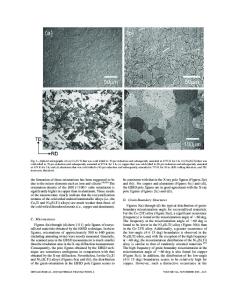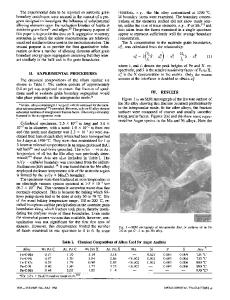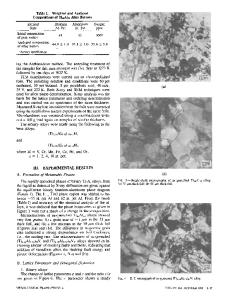Effect of Ordering Energy on Grain Boundary Structure in L1 2 Alloys
- PDF / 1,139,937 Bytes
- 7 Pages / 420.48 x 639 pts Page_size
- 52 Downloads / 900 Views
Effect of Ordering Energy on Grain Boundary Structure in L12 Alloys G.J.Ackland and V.Vitek Department of Materials Science and Engineering University of Pennsylvania Philadelphia, PA1 9104-6272
ABSTRACT Atomic structures of grain boundaries in two L12 ordered alloys with very different ordering energies have been calculated. The interatomic forces are represented by many-body empirical potentials based on the second moment approximation to the tightbinding density of states. Grain boundaries in strongly ordered alloys show very little relaxation. This results in the presence of columns of cavities in the boundaries. On the other hand boundaries in weakly ordered alloys, and also in pure f.c.c. materials, show extensive relaxations leading to much more homogeneous structures. We suggest that these structural features may be responsible for the intrinsic brittleness of grain boundaries in compounds such as Ni3AI in contrast with boundaries in pure f.c.c. metals or ordered alloys such as Cu 3Au which are only embrittled by segregation.
INTRODUCTION
The mechanical behaviour of intermetallic compounds with the f.c.c. based Li 2 structure often contrasts sharply with that of pure f.c.c. metals and disordered alloys. The flow stress in compounds is generally much higher than in pure f.c.c. materials and the yield stress frequently shows an anomalous temperature dependence at high temperatures accompanied, for example in Ni3AI, by strong orientation dependences of the yield stress [1,2]. Furthermore, in polycrystalline form Ni3AI is brittle and fractures in an intergranular manner even when there is no appreciable segregation of impurities to the grain boundaries. Hence, the grain boundary brittleness appears to be an intrinsic property of this compound [3,4,5]. On the other hand, a number of ordered alloys with the same crystal structure, for example Cu 3Au, are ductile as polycrystals. Alloying may affect dramatically the ductility of the L12 compounds. A pronounced example is the effect of boron on Ni3AI. When boron segregates to the grain boundaries the intergranular fracture may be entirely suppressed. However, this occurs only in offstoichiometric, Ni rich alloys, the effect is very small in the stoichiometric case. This suggests that the deviation from stoichiometry is at least as important as alloying by boron. [4-9]. It has been shown in earlier studies that the plastic behaviour of Li2 compounds is closely linked with the strength of ordering. For example, in weakly ordered Cu 3Au alloys the anomalous peak in the yield stress vs. temperature dependence occurs very near the order-disorder temperature. The physical reason for this anomalous temperature dependence of the flow stress is an increasing density of antiphase boundaries (APBs) with temperature which act as obstacles for dislocation motion [1]. In strongly ordered Ni3AI, transformations of the dislocation cores from glissile to sessile form are responsible for the anomalous temperature dependence of the yield stress [1,2,10]. However, in a very strongl
Data Loading...











